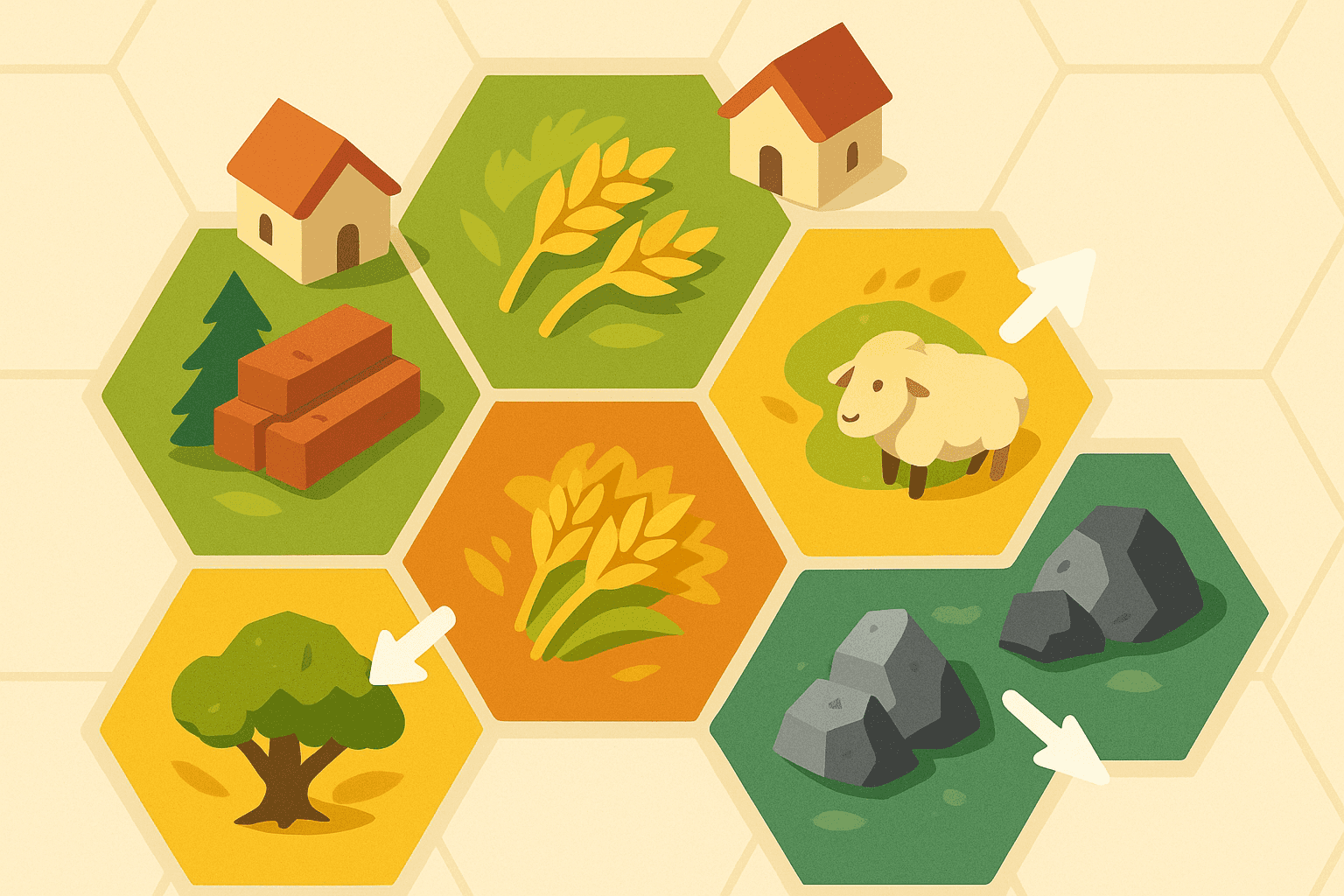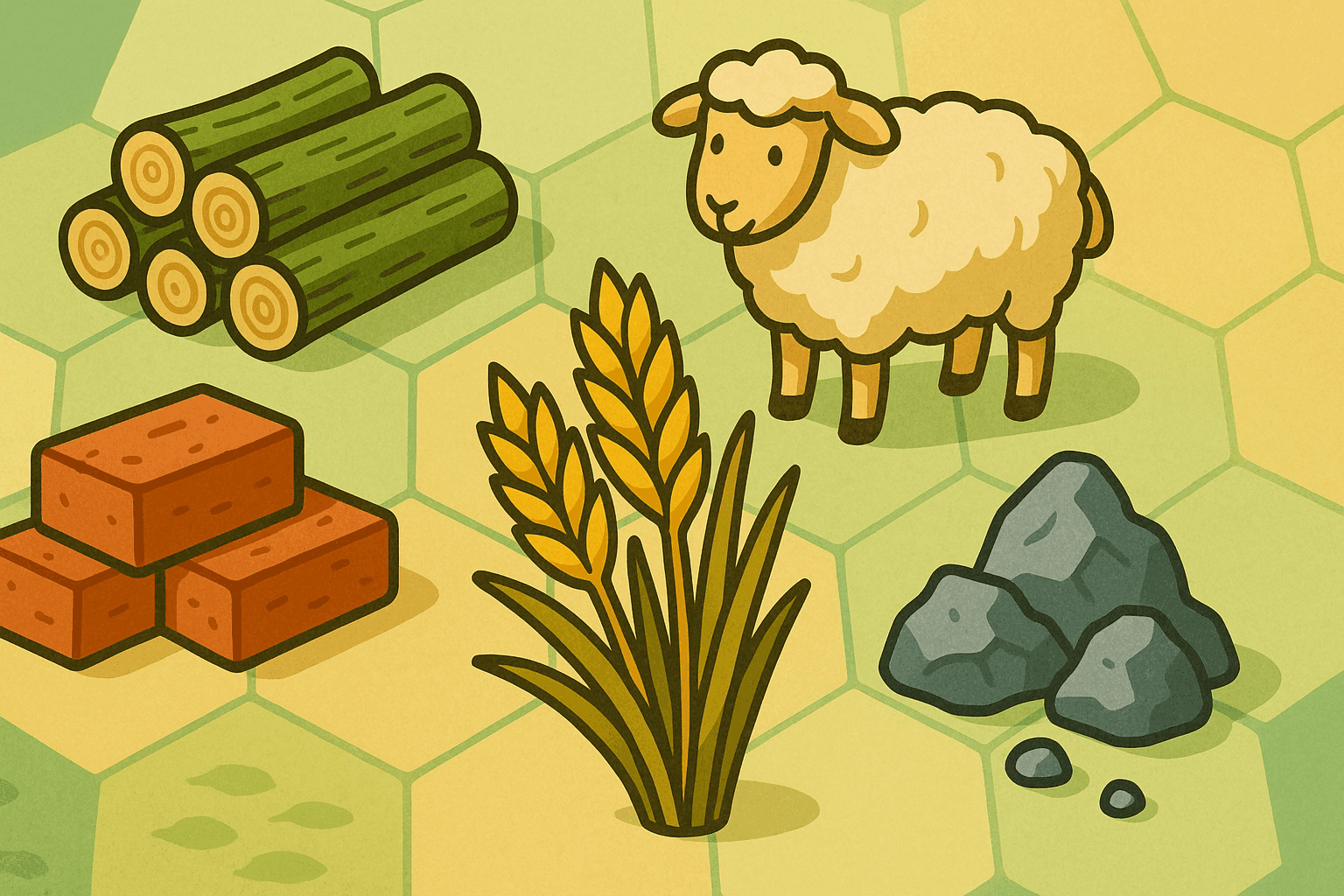
Catan Openings for New Players: Placement, Ports, Tempo
Openings decide your production, your expansion lanes, and how fast you turn resources into points. If you already know the basics of Catan, this guide gives you three beginner-friendly opening patterns and simple checklists for the first two placements, early road plans, and port timing.
Created By Adam Davis Fernsby
What a good opening looks like
Number distribution and reliability
Think of pips (the dots on 2–12) as expected production. The 6 and 8 are premium, but don’t tunnel on them. As a beginner, aim to sit on two to three strong numbers spread across your two starting settlements. A mix like 6/9/10 or 8/5/10 is usually steadier than stacking both settlements on 6/8 only. A balanced spread reduces robber pain and bad variance.
Resource coverage (how many types you actually get)
Covering four resources is a safe baseline; five is great but not mandatory if your expansion path fixes the missing one. For tempo, Brick + Wood fuel roads and early expansion, while Ore + Wheat fuel cities and development cards. Try to start with Brick or Wood plus Wheat, then add the missing side (Ore or the other road resource) with your second placement or first expansion.
Tempo (turning production into points quickly)
Tempo means how fast you convert resources into settlements, cities, and development cards. Road/settle tempo is fastest when you reliably produce Brick + Wood early. City/dev tempo accelerates once you have Ore + Wheat. Your opening should either:
- explode out of the gate with roads to claim key intersections, or
- climb to a quick first city or dev engine and then branch for roads.
Three safe opening patterns
Each pattern includes when to pick it, how to place your first and second settlement, and early road/port ideas. Adapt to the board if opponents block a key hex, switch pattern.
Road Runner (Brick/Wood first, expand to Wheat/Sheep)
When to choose: You spot a premium Brick/Wood corner (e.g., 6–8–5 with at least one of Brick/Wood doubled) and see an open lane toward Wheat or Sheep.
Plan:
- First settlement on a high-pip Brick/Wood triad to guarantee road tempo. Point your free road toward an open intersection (ideally touching Wheat or Sheep).
- Second settlement covers Wheat and preferably a flexible number like 9/10/5.
- Spend early turns on road → settlement, then pick up the third resource you lack (often Ore) via expansion or trades.
Watch-outs: Don’t ignore Wheat - without it you stall on cities/devs. Protect your lane with the initial free road so opponents can’t pinch your expansion target.
City Sprint (Ore/Wheat/Sheep core, add Wood or Brick later)
When to choose: A strong 6/8 on Ore/Wheat is open, with Sheep on a decent number (5/9/10). Remote or blocked roads make fast expansion tough.
Plan:
- First settlement on Ore/Wheat/Sheep with good pips.
- Second settlement picks up Wood or Brick (ideally both via an okay triad) so you can still place one more settlement soon.
- Aim for early development cards and a fast first city. A Knight protects you from the robber; Year of Plenty or Monopoly can swing tempo.
Watch-outs: You will be slower on roads. Secure a trade partner, eye a 3:1 port, and don’t sit forever without Wood/Brick access.
Port Plan (stack a resource, convert it efficiently)
When to choose: The board gives you double-up production in one resource (e.g., two solid Wheat spots) and a nearby 2:1 or 3:1 port exists along a safe road.
Plan:
- First settlement on a high-production cluster that naturally overproduces one resource.
- Second settlement covers your biggest gap (often Brick or Wood) and points your road toward a matching port.
- Settle the port by turn 3–4 so your overproduction converts into whatever you’re missing.
Watch-outs: A port without volume is dead weight. Build production first, then port. Don’t choose a 2:1 port if you only trickle that resource.
First placement vs second placement (snake draft reality)
If you place first
You’ll place again at the end of the first round. Take the best production triad on the board (strong numbers + at least two vital resources) and use your free road to secure direction toward an open intersection or port. Because your second placement comes last, you can then counter-draft: grab a synergistic second spot that covers your missing resources and blocks an opponent’s plan if possible.
If you place last (and then first)
You place twice in a row. Grab two synergistic settlements: one that gives Brick/Wood for road tempo, and a second that gives Ore/Wheat/Sheep for city/dev tempo. Ensure at least four unique resources total across the two placements. Because you act back-to-back, you can sculpt a coherent plan (e.g., Road Runner into City Sprint) and set both free roads to protect key lanes.
Ports without pitfalls
3:1 vs 2:1
A 3:1 port is flexibility - any three of the same convert into one of your choice, perfect if your production is mixed but spiky. A 2:1 port is power -fantastic if you truly overproduce that specific resource (e.g., Wheat double-up), but weak if your flow is inconsistent.
Timing
Settle a port after you have the production to use it every couple of turns. The common beginner mistake is to take the port too early and then wait several turns to do anything with it. Exceptions: securing the only relevant 3:1 before it’s gone, or grabbing a 2:1 that your whole plan revolves around.
Beginner mistakes to avoid
- Chasing only pips and ignoring resource mix. Two 6/8s with Sheep only won’t build roads or cities.
- Forgetting Wheat. Cities and development cards both need Wheat; don’t let it be your sole dependency on a weak number.
- Early port with no production base. Ports convert volumebuild volume first.
- Roads to nowhere. Always point roads toward a specific intersection you plan to settle.
- Overstacking on one number. It invites robber targeting and variance - add a second reliable number.
Sample turn plans (scripts you can follow)
Brick/Wood start (Road Runner):
Turn 1–2: road → settlement on Wheat; trade extra Brick/Wood to fix missing piece.
Turn 3–4: snag a flexible number (9/10/5), then consider a dev card if your Wheat/Ore appear; otherwise continue road → settle to dominate space.
Ore/Wheat start (City Sprint):
Turn 1–2: buy a dev card, save for a city; hold a Knight to move the robber.
Turn 3–4: place first city; expand for Wood/Brick; consider a 3:1 if trades are tight.
Port plan:
Turn 1–2: expand along the safe lane toward the port, keeping one alternate intersection as a fallback.
Turn 3–4: settle the port; immediately convert overflow into the resource you lacked to secure a settlement or city.
Quick reference tables
Opening checkup
| Question | Good answer (beginner) |
|---|---|
| Do you cover at least 4 resources across two settlements? | Yes (ideally Brick/Wood + Wheat + one of Ore/Sheep) |
| Do you sit on 2–3 strong numbers (not all the same)? | Yes (mix of 6/8 with 5/9/10) |
| Do your free roads protect expansion lanes? | Yes (aimed at an open intersection or port) |
| Is Wheat secured on a decent number? | Yes (it fuels cities and devs) |
| Do you have a fallback if blocked? | Yes (alternate lane or trade/port plan) |
Pattern cheat sheet
| Pattern | Numbers you want | First upgrade | First goal |
|---|---|---|---|
| Road Runner | 6/8/5 on Brick/Wood + a 9/10 Wheat path | Extra settlement | Connect to Wheat, then expand |
| City Sprint | 6/8 plus 5/9 on Ore/Wheat/Sheep | First city | 1–2 dev cards for leverage |
| Port Plan | Doubled resource + nearby 3:1 or matching 2:1 | Settlement on port | Convert overflow to fix gaps |
Concrete board examples (to visualize)
- Road Runner: A 6–8–4 Brick/Wood corner with a free road aiming at a 9 Wheat. Your second settlement sits on 9–10–3 touching Wheat/Sheep, giving four resources and two lanes.
- City Sprint: A 6–8–3 Ore/Wheat/Sheep anchor plus a 10–5–4 Wood/Brick triad. First city on the 6/8; then roads from the Wood/Brick corner.
- Port Plan: Two decent Wheat intersections (6 and 9) with a short road to a 2:1 Wheat port. Once settled, two Wheat convert into whatever you’re missing that turn.
Robber and trading basics for openings
Use an early Knight from a dev card to keep the robber off your best hex. When trading, prefer ratio-positive swaps that advance your immediate goal (settlement or city this turn). Don’t donate tempo - if a trade helps an opponent settle into your lane, pass.
Conclusion
Your first two placements should set a clear path: either sprint with roads to lock down space, climb to a fast city and dev leverage, or channel overproduction through a timely port. Start with one of these three patterns, adapt to the board, and you’ll feel your tempo improve game by game. If this helped, keep exploring our beginner guides across modern board games.



